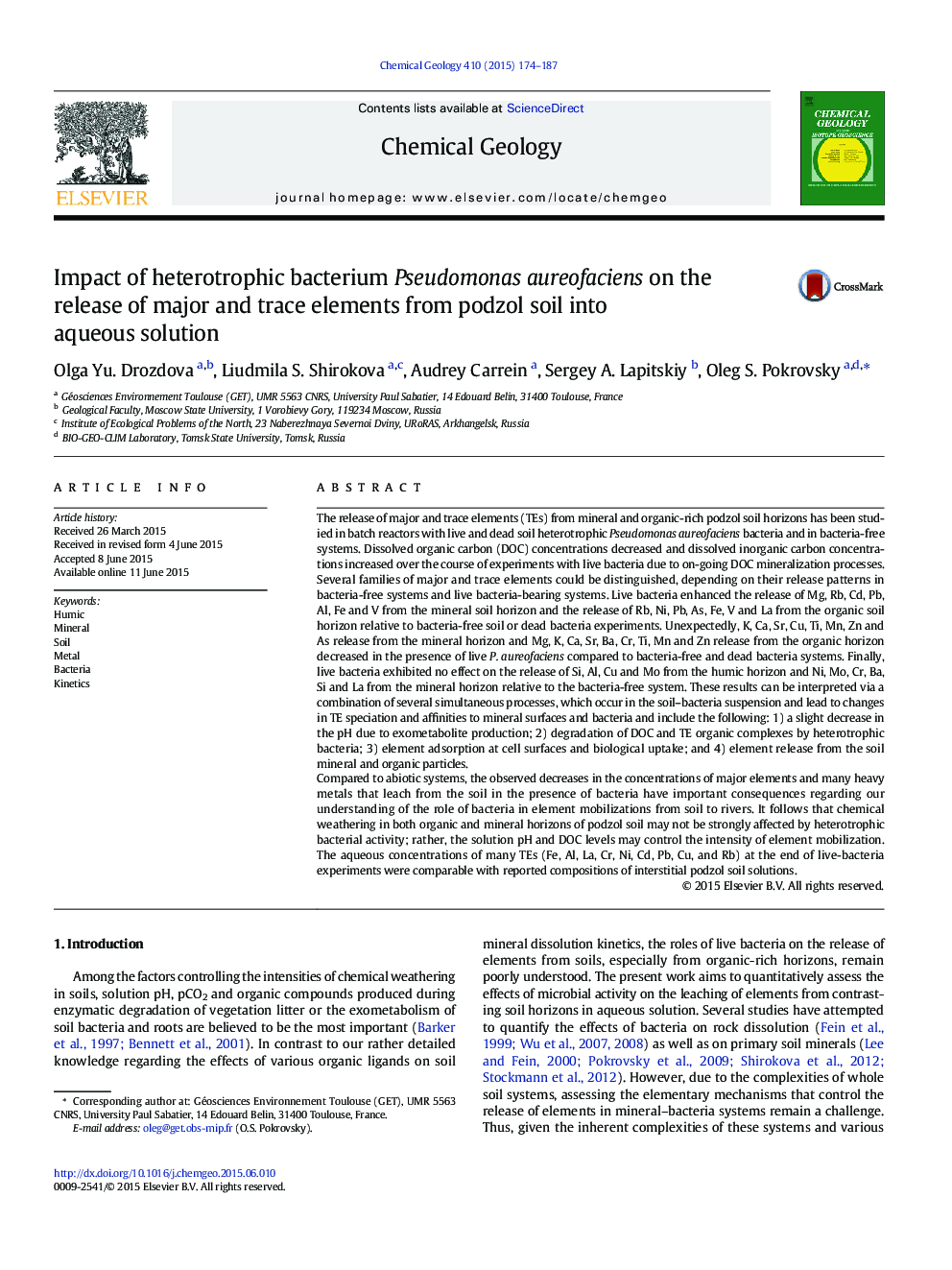| کد مقاله | کد نشریه | سال انتشار | مقاله انگلیسی | نسخه تمام متن |
|---|---|---|---|---|
| 4698493 | 1637564 | 2015 | 14 صفحه PDF | دانلود رایگان |

• Live bacteria enhance the release of Pb, Fe, V, Ni, Cd and Rb from soil.
• The release of K, Ca, Sr, Ti, Mn and Zn from soil decreases in the presence of bacteria.
• Live bacteria exhibit no effect on Cu, Al, Mo and Cr release from soil.
• Mineralization of organic complexes and desorption may control the release.
• Experimental TE concentrations were similar to natural concentrations.
The release of major and trace elements (TEs) from mineral and organic-rich podzol soil horizons has been studied in batch reactors with live and dead soil heterotrophic Pseudomonas aureofaciens bacteria and in bacteria-free systems. Dissolved organic carbon (DOC) concentrations decreased and dissolved inorganic carbon concentrations increased over the course of experiments with live bacteria due to on-going DOC mineralization processes. Several families of major and trace elements could be distinguished, depending on their release patterns in bacteria-free systems and live bacteria-bearing systems. Live bacteria enhanced the release of Mg, Rb, Cd, Pb, Al, Fe and V from the mineral soil horizon and the release of Rb, Ni, Pb, As, Fe, V and La from the organic soil horizon relative to bacteria-free soil or dead bacteria experiments. Unexpectedly, K, Ca, Sr, Cu, Ti, Mn, Zn and As release from the mineral horizon and Mg, K, Ca, Sr, Ba, Cr, Ti, Mn and Zn release from the organic horizon decreased in the presence of live P. aureofaciens compared to bacteria-free and dead bacteria systems. Finally, live bacteria exhibited no effect on the release of Si, Al, Cu and Mo from the humic horizon and Ni, Mo, Cr, Ba, Si and La from the mineral horizon relative to the bacteria-free system. These results can be interpreted via a combination of several simultaneous processes, which occur in the soil–bacteria suspension and lead to changes in TE speciation and affinities to mineral surfaces and bacteria and include the following: 1) a slight decrease in the pH due to exometabolite production; 2) degradation of DOC and TE organic complexes by heterotrophic bacteria; 3) element adsorption at cell surfaces and biological uptake; and 4) element release from the soil mineral and organic particles.Compared to abiotic systems, the observed decreases in the concentrations of major elements and many heavy metals that leach from the soil in the presence of bacteria have important consequences regarding our understanding of the role of bacteria in element mobilizations from soil to rivers. It follows that chemical weathering in both organic and mineral horizons of podzol soil may not be strongly affected by heterotrophic bacterial activity; rather, the solution pH and DOC levels may control the intensity of element mobilization. The aqueous concentrations of many TEs (Fe, Al, La, Cr, Ni, Cd, Pb, Cu, and Rb) at the end of live-bacteria experiments were comparable with reported compositions of interstitial podzol soil solutions.
Figure optionsDownload as PowerPoint slide
Journal: Chemical Geology - Volume 410, 2 September 2015, Pages 174–187